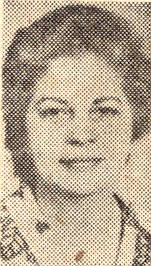By JEAN
BARNES
Modern Living Writer
"Cast iron mechanical banks and
toys are marvels of American ingenuity and skill."
This is the opinion of Frank Laughlin who owns an extensive
collection of banks and toys which date from the 19th century.
Perhaps no other collectible item so completely reflects the times
and manners of the periods in which they were manufactured. In many
instances they are a comment on historical events.
Laughlin's collection of banks and toys reveal the interest of the
times — sports, circus, politics. Some invoke
humor, satire or prejudice. Other toys were made with a great deal of
realism and include trains, fire engines, carriages and early automobiles.
BIBLE TOYS, such as Jonah and the Whale and Noah's Ark were the only
toys many children in religious households were allowed to play with on
Sunday, Laughlin pointed out.
His collection is
representative of all these types, but for simplicity's sake he has
classified his collection in three divisions – mechanical banks, toys and
bell-ringer toys.
Most mechanical banks were constructed of cast iron which is quite
heavy. For this reason, the coin depository is usually in a pierced or
1acy pattern to lessen the weight of the bank. In the "Uncle Sam" bank
pictured, the coin is placed on his outstretched hand. By tripping a
lever, the bank is set in motion. In the blink of an eye, the satchel pops
open and the coin drops in, leaving Uncle Sam's chin whiskers quivering.
Mechanical banks work with such intricate, split second timing they have
an almost magical quality.
BELL-RINGERS are a special favorite of the collector. "Usually toys
made for girls, such as the bell toys, have survived in a better condition
than those made for boys.
"However, after 20 years, very few of any type toy will survive and
then usually because of some unusual circumstance."
Cast iron toys and banks were made mainly between 1870 and 1910, by
the hundreds of thousands. Most were sold for less than $1 or $2.
"Remember, $10 weekly was a good wage for long hours," Laughlin explained.
The workmen became extremely skilled in the casting and use of cast
iron and the casting was exceptionally smooth and very intricate. Patterns
were hand painted by women for very small wages.
Laughlin, owner of Laughlin's Furniture Store, has a few of his toys
on display in his store. Others are housed in lighted cabinets in his
home. His collection of animated toy pistols is arranged in a glass
enclosed display case. These pistols are a subject which will be covered
in next week's column.
TOYS DO NOT necessarily have to be old to be collectable. Although
Laughlin, with few exceptions, has confined his collection to the
1870-1910 era, many collectors are picking up toys manufactured as late as
the 1950s. The low survival fate is one reason for this.
Another reason is the historical connotation of many modern-day toys
.The supply of really fine old toys has dwindled, with most of them now in
the hands of collectors and the remaining ones drawing premium prices. New
collectors are turning to the mid-20th century toys that still are found
in abundance.
Toys are fun, not only for children but for grown-up collectors.
"One, of the greatest pleasures in collecting is the fine people you meet
and the friends you make," Laughlin said. He has received correspondence
from every state and from Europe as well as phone calls from persons
seeking information or just wanting to visit.
Q: WE HAVE a pair of figures of a man and a woman that are china but
we would like to know what kind. They look rather chalky and aren’t shiny
like so many we've seen.
A: FROM YOUR description I feel that your figurines are of bisque
china. This type of porcelain is unglazed and remains in the biscuit stage
of firing. The color applied to the faces and clothing is done by hand but
generally not affixed through the additional application of the glaze and
the final firing of the glazed portion. This process is less expensive
than that of the finished glazed product. This type of figurine was both
abundant and popular during the mid-Victorian era. Figurines and busts
were the most popular items made but vases, boxes and other items were
included in its production.
Bisque was prevalent in Europe. Later Bisque figures came from the
orient and some pottery houses made these in America. Bennington was
probably the most fruitful of all. The French bisque is, the finest and by
far the most valuable. Japanese copies are generally very poor quality and
quite inexpensive. Bisque is easy to copy and a good copy is difficult to
detect even by the trained eye so caution should be taken when collecting.
Your questions are invited. Donald D. Taylor Jr., a member of the
American Appraisers Assn., serves as consultant for this column and will
answer questions of a general interest. Monetary appraisals will not be
given. Send your question to: Today's Treasures, The Wichita Eagle &
Beacon, P.O. Box 820, Wichita, Kan. 67201.



